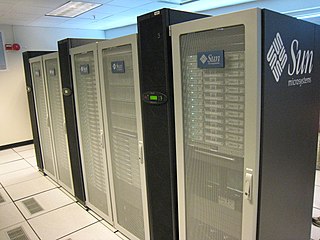The Red Hat Cluster includes software to create a high availability and load balancing cluster. Both can be used on the same system although this use case is unlikely. Both products, the High Availability Add-On and Load Balancer Add-On, are based on open-source community projects. Red Hat Cluster developers contribute code upstream for the community. Computational clustering is not part of cluster suite, but instead provided by Red Hat MRG.
The High Availability Add-On is Red Hat's implementation of Linux-HA. It attempts to ensure service availability by monitoring other nodes of the cluster. All nodes of the cluster must agree on their configuration and shared services state before the cluster is considered to have a quorum and services are able to be started.
The primary form of communicating node status is via a network device (commonly Ethernet), although in the case of possible network failure, quorum can be decided through secondary methods such as shared storage or multicast.
Software services, filesystems and network status can be monitored and controlled by the cluster suite, services and resources can be failed over to other network nodes in case of failure.
The Cluster forcibly terminates a cluster node's access to services or resources, via fencing, to ensure the node and data is in a known state. The node is terminated by removing power (known as STONITH) or access to the shared storage. More recent versions of Red Hat use a distributed lock manager, to allow fine grained locking and no single point of failure. Earlier versions of the cluster suite relied on a "grand unified lock manager" (GULM) which could be clustered, but still presented a point of failure if the nodes acting as GULM servers were to fail. GULM was last available in Red Hat Cluster Suite 4.
Red Hat adapted the Piranha load balancing software to allow for transparent load balancing and failover between servers. The application being balanced does not require special configuration to be balanced, instead a Red Hat Enterprise Linux server with the load balancer configured, intercepts and routes traffic based on metrics/rules set on the load balancer.
Red Hat cluster suite support is tied to a matching version of Red Hat Enterprise Linux and follows the same maintenance policy. The product has no activation, time limit or remote kill switch, it will remain working after the support life cycle has ended. It is partially supported running under VMware Virtual Machine. [1]
The cluster suite is available in:

Red Hat, Inc. is an American IBM subsidiary software company that provides open source software products to enterprises. Founded in 1993, Red Hat has its corporate headquarters in Raleigh, North Carolina, with other offices worldwide.
Sistina Software was a US company that focused on storage solutions designed around a Linux platform. It originated in the University of Minnesota.
OpenSSI is an open-source single-system image clustering system. It allows a collection of computers to be treated as one large system, allowing applications running on any one machine access to the resources of all the machines in the cluster.
In computing, the Global File System 2 or GFS2 is a shared-disk file system for Linux computer clusters. GFS2 allows all members of a cluster to have direct concurrent access to the same shared block storage, in contrast to distributed file systems which distribute data throughout the cluster. GFS2 can also be used as a local file system on a single computer.
In computing, remote direct memory access (RDMA) is a direct memory access from the memory of one computer into that of another without involving either one's operating system. This permits high-throughput, low-latency networking, which is especially useful in massively parallel computer clusters.
Google File System is a proprietary distributed file system developed by Google to provide efficient, reliable access to data using large clusters of commodity hardware. The last version of Google File System codenamed Colossus was released in 2010.
Lustre is a type of parallel distributed file system, generally used for large-scale cluster computing. The name Lustre is a portmanteau word derived from Linux and cluster. Lustre file system software is available under the GNU General Public License and provides high performance file systems for computer clusters ranging in size from small workgroup clusters to large-scale, multi-site systems. Since June 2005, Lustre has consistently been used by at least half of the top ten, and more than 60 of the top 100 fastest supercomputers in the world, including the world's No. 1 ranked TOP500 supercomputer in June 2020, Fugaku, as well as previous top supercomputers such as Titan and Sequoia.
High-availability clusters are groups of computers that support server applications that can be reliably utilized with a minimum amount of down-time. They operate by using high availability software to harness redundant computers in groups or clusters that provide continued service when system components fail. Without clustering, if a server running a particular application crashes, the application will be unavailable until the crashed server is fixed. HA clustering remedies this situation by detecting hardware/software faults, and immediately restarting the application on another system without requiring administrative intervention, a process known as failover. As part of this process, clustering software may configure the node before starting the application on it. For example, appropriate file systems may need to be imported and mounted, network hardware may have to be configured, and some supporting applications may need to be running as well.

Oracle Solaris Cluster is a high-availability cluster software product for Solaris, originally created by Sun Microsystems, which was acquired by Oracle Corporation in 2010. It is used to improve the availability of software services such as databases, file sharing on a network, electronic commerce websites, or other applications. Sun Cluster operates by having redundant computers or nodes where one or more computers continue to provide service if another fails. Nodes may be located in the same data center or on different continents.
Gluster Inc. was a software company that provided an open source platform for scale-out public and private cloud storage. The company was privately funded and headquartered in Sunnyvale, California, with an engineering center in Bangalore, India. Gluster was funded by Nexus Venture Partners and Index Ventures. Gluster was acquired by Red Hat on October 7, 2011.
A clustered file system is a file system which is shared by being simultaneously mounted on multiple servers. There are several approaches to clustering, most of which do not employ a clustered file system. Clustered file systems can provide features like location-independent addressing and redundancy which improve reliability or reduce the complexity of the other parts of the cluster. Parallel file systems are a type of clustered file system that spread data across multiple storage nodes, usually for redundancy or performance.
Ceph is an open-source software-defined storage platform that implements object storage on a single distributed computer cluster and provides 3-in-1 interfaces for object-, block- and file-level storage. Ceph aims primarily for completely distributed operation without a single point of failure, scalability to the exabyte level, and to be freely available. Since version 12, Ceph does not rely on other filesystems and can directly manage HDDs and SSDs with its own storage backend BlueStore and can completely self reliantly expose a POSIX filesystem.

Linoma Software was a developer of managed file transfer and encryption solutions. The company was acquired by HelpSystems in June 2016. Mid-sized companies, large enterprises and government entities use Linoma's solutions to protect sensitive data and comply with data security regulations such as PCI DSS, HIPAA/HITECH, SOX, GLBA and state privacy laws. Linoma's software runs on a variety of platforms including Windows, Linux, UNIX, IBM i, AIX, Solaris, HP-UX and Mac OS X.

BeeGFS is a parallel file system, developed and optimized for high-performance computing. BeeGFS includes a distributed metadata architecture for scalability and flexibility reasons. Its most used and widely known aspect is data throughput.
Device Mapper Multipath Input Output often shortened to DM-Multipathing and abbreviated as DM-MPIO provides input-output (I/O) fail-over and load-balancing by using multipath I/O within Linux for block devices. By utilizing device-mapper, the multipathd daemon provides the host-side logic to use multiple paths of a redundant network to provide continuous availability and higher-bandwidth connectivity between the host server and the block-level device. DM-MPIO handles the rerouting of block I/O to an alternate path in the event of a path failure. DM-MPIO can also balance the I/O load across all of the available paths that are typically utilized in Fibre Channel (FC) and iSCSI SAN environments. DM-MPIO is based on the device mapper, which provides the basic framework that maps one block device onto another.
A distributed file system for cloud is a file system that allows many clients to have access to data and supports operations on that data. Each data file may be partitioned into several parts called chunks. Each chunk may be stored on different remote machines, facilitating the parallel execution of applications. Typically, data is stored in files in a hierarchical tree, where the nodes represent directories. There are several ways to share files in a distributed architecture: each solution must be suitable for a certain type of application, depending on how complex the application is. Meanwhile, the security of the system must be ensured. Confidentiality, availability and integrity are the main keys for a secure system.

Proxmox Virtual Environment is an open-source software server for virtualization management. It is a hosted Type-2 hypervisor that can run operating systems including Linux and Windows on x64 hardware. It is a Debian-based Linux distribution with a modified Ubuntu LTS kernel and allows deployment and management of virtual machines and containers. Proxmox VE includes a web console and command-line tools, and provides a REST API for third-party tools. Two types of virtualization are supported: container-based with LXC, and full virtualization with KVM. It includes a web-based management interface.
ONTAP or Data ONTAP or Clustered Data ONTAP (cDOT) or Data ONTAP 7-Mode is NetApp's proprietary operating system used in storage disk arrays such as NetApp FAS and AFF, ONTAP Select and Cloud Volumes ONTAP. With the release of version 9.0, NetApp decided to simplify the Data ONTAP name and removed word "Data" from it and remove 7-Mode image, therefore, ONTAP 9 is successor from Clustered Data ONTAP 8.